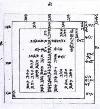|
|
 |
The capitals of the Chinese Dynasties more or less corresponded to the Fengshui pattern: a river to the south and a hill to the north, sometimes there was the need to pile up an artificial mountain or to divert a creek. All cities in China were fortified with a city wall (cheng 城) and enclosed dwelling quarters of population, merchants and guilds; one or more markets (shi 市); and the administration buildings respectively the imperial palace of the capital city. The modern Chinese word for city, chengshi 城市, is composed of the terms for "wall" and "market". Administratorial buildings were normally located in the central or northern part of the city, the inner or private buildings of the emperor or magistrate or whoever in the north, official halls to the south. The emperor or his representant is facing the south, the subjects bowing to the north.
Many dynasties had more than one capital city. The following table shall give an overview of the capital cities (secondary capitals and the capitals of minor dynasties are not included in this table):
 The picture on the right top shows a map of the imperial palace of the Tang Dynasty 唐 from Li Haowen's 李昊文 description of Chang'an Chang'an zhitu 長安志圖 (written during Yuan 元). The link will show an enlarged copy of the city plan, south to the top like it was use in traditional Chinese maps. Except the north, every side of the square city has three gates. The outer square is the city wall (jingcheng 京城), the middle square the wall of the imperial quarter (huangcheng 皇城), and the inner square represents (not in a real scale) the wall of the imperial palace (gongcheng 宮城). The text within the palace square reflects the names of the gates and halls inside the palace area. The halls are, from south to north, the Taijidian 太極殿 "Hall of the highest extreme", Liangyidian 兩儀殿 "Hall of the two principles (Heaven and Earth; here begins the Inner Court neichao 內朝)", and Ganludian 甘露殿 "Hall of sweet dew". Compare the names of the Imperial Palace in Beijing. The picture on the right top shows a map of the imperial palace of the Tang Dynasty 唐 from Li Haowen's 李昊文 description of Chang'an Chang'an zhitu 長安志圖 (written during Yuan 元). The link will show an enlarged copy of the city plan, south to the top like it was use in traditional Chinese maps. Except the north, every side of the square city has three gates. The outer square is the city wall (jingcheng 京城), the middle square the wall of the imperial quarter (huangcheng 皇城), and the inner square represents (not in a real scale) the wall of the imperial palace (gongcheng 宮城). The text within the palace square reflects the names of the gates and halls inside the palace area. The halls are, from south to north, the Taijidian 太極殿 "Hall of the highest extreme", Liangyidian 兩儀殿 "Hall of the two principles (Heaven and Earth; here begins the Inner Court neichao 內朝)", and Ganludian 甘露殿 "Hall of sweet dew". Compare the names of the Imperial Palace in Beijing.
|
|
|